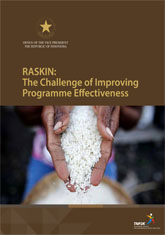Raskin: The Challenge of Improving Programme Effectiveness
May 2015
Raskin – the Rice for the Poor Programme – has been implemented since 2002 and evolved from OPK (operasi pasar khusus or market operation for the sale of subsidised rice), a cross-sectoral national rice subsidy programme imple- mented in 1998. Rice subsidies are particularly important in addressing poverty since rice accounts for nearly 30 percent of the expenditure of poor households.
Raskin’s effectiveness is measured in terms of six benchmarks. Often referred to as the ‘6Ts’, the benchmarks include (i) targeting of beneficiaries, (ii) quantity, (iii) price, and (iv) quality of rice, (v) timeliness of delivery and (vi) programme administration. While the implementation of Raskin is not without its challenges, the government has the time and space to initiate reforms to fulfill the 6Ts in the future.
‘The Challenge of Improving Raskin’s Effectiveness’ highlights the steps, policies and mechanisms applied to the Raskin programme by the National Team for the Acceleration of Poverty Reduction (TNP2K) over the past four years. The report also examines some of the innovative thinking and strategic breakthroughs needed to move the programme forward. We invite all our readers to provide feedback on the contents of this report in order to improve the Raskin programme in the future
*This report is available in Bahasa Indonesia and English
You are free to copy, distribute and transmit this report for non-commercial purposes. To request a copy of this report or further information, please contact the TNP2K-Knowledge Management Unit (kmu@tnp2k.go.id).
